Post-Fertilisation: Development of Seed & Fruit | Biology for JAMB PDF Download
| Table of contents |

|
| ➢ Structure of Seed |

|
| ➢ Monocotyledonous and Dicotyledonous Seed |

|
| ➢ Germination of Seed |

|
| ➢ Dormancy of Seed |

|
| Old NCERT Syllabus |

|
➢ Structure of Seed
- The whole plant exists in a seed. The plant is the main base of the whole living world. So it can be said that the seed is the most important structure.
- In angiosperm, after the fertilization, the egg cell changed into an embryo, ovary changed into fruit and ovule change into seed.
- Morphologically, the ripened ovule is known as the seed. In other words, seed is a mature, integumented megasporangium.
- Seeds are characteristic of Spermatophytes (Gymnosperms and Angiosperms).
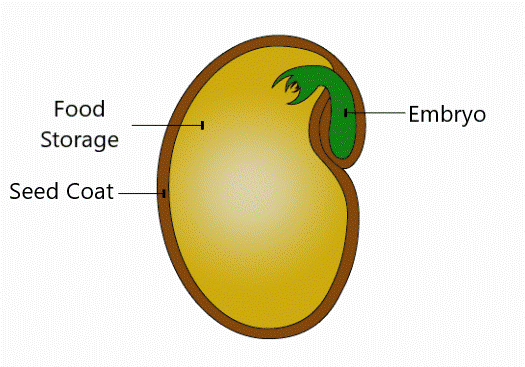 Structure of Seed
Structure of Seed
A typical mature seed is having three main parts:
1. Seed Coat
- The outer, protective covering of the seed is called the seed coat, which develops from integuments of the ovule. In seeds developing from bitegmic ovules, there are two distinct layers in the seed coat.
- The outer layer is thick, hard and leathery (developing from outer integument), called testa, whereas the inner layer is thin and papery or membranous (developing from inner integument), called tegmen.
- In seeds developing from unitegmic ovules, there is a single-layered seed coat. The seed coat performs the usual protective function.
- The seed is attached to the fruit wall or pericarp by means of a stalk called funicle or funiculus. The point of attachment of funiculus to the body of the mature seed is called hilum.
- A small opening or pore called micropyle is present just near the hilum, which is the way of entry of water into the seed. As most of the ovules in angiosperms are inverted or anatropous, so a ridge called raphe is present.
2. Embryo
- The embryo is the most important part of the seed, which represents a minor tiny future plant. Embryo develops from fertilized egg (zygote).
- The embryo is having an embryonal axis or main axis called tigellum, to which one or two cotyledons (seed leaves) are attached, depending upon whether the seed is monocot or dicot.
- The portion of the embryonal axis or tigellum below the point of attachment of cotyledons is called hypocotyl, which bears a radicle or future root at its tip.
- Similarly, a portion of the embryonal axis or tigellum above the point of attachment of cotyledons is called epicotyl, which bears plumule (future shoot) at its tip.
3. Endosperm
- It is the nutritive tissue that may be present or absent in the seeds.
The angiospermic seed is classified into two categories on the basis of presence or absence of endosperm in seeds:
- Non-Endospermic or Ex-Albuminous Seed
- Endospermic or Albuminous Seed
(i) Non-Endospermic or Ex-Albuminous Seed: Such type of seeds do not have an endosperm at maturity, therefore are called non-endospermic or exalbuminous seeds. The endospermic tissues are absorbed during the development of the embryo. The absorbed food materials from the endosperm are stored in cotyledons, that why they become so large and fleshy.
Example: Capsella and most of the dicotyledons. But Castor seed is endospermic.
Non-endospermic dicot seeds: Gram, Bean, Pea, cucumber, Tamarind.
Non-endospermic monocot seeds: Pothos (money plant), Vallisneria, Alisma, Amorphophallus.
(ii) Endospermic or Albuminous seed: This type of seeds, food is stored in endosperm. Such seeds are called endospermic seed or Albuminous seed. The endospermic tissue in these seeds utilize during the germination of seed and their cotyledons are thin and membranous.
Example: Most Monocot seeds like Wheat, Rice, and Maize etc.
Endospermic dicot seeds: Castor, Papaya, Cotton.
Endospermic monocot seeds: Maize, Rice, Wheat and Coconut.
Note:
Sometimes, some part of the nucleus remains unused which is present in the form of a thin layer around the endosperm is called perisperm.
Example: Betelnut, Black pepper, Castor.
➢ Monocotyledonous and Dicotyledonous Seed
- In Monocotembryo, there is a single cotyledon called scutellum.
Example: Grasses like Wheat. - On the opposite side of the scutellum is a tongue-shaped outgrowth remains of the second cotyledon is present called epiblast.
- In Dicot albuminous seed-castor (Ricinus communis), there is a specific outgrowth called caruncle or strophiole, present over micropyle. It is formed by the proliferation of cells of the outer integument at the tip. The caruncle is somewhat spongy and helps in the absorption of water during the germination of seed.
- On the basis of cotyledon in the seed of angiosperm are called Monocotyledon (one cotyledon) and Dicotyledons (two cotyledons).
 Monocotyledonous and Dicotyledonous Seed
Monocotyledonous and Dicotyledonous Seed
Table: Difference between Monocotyledonous and Dicotyledonous Seed
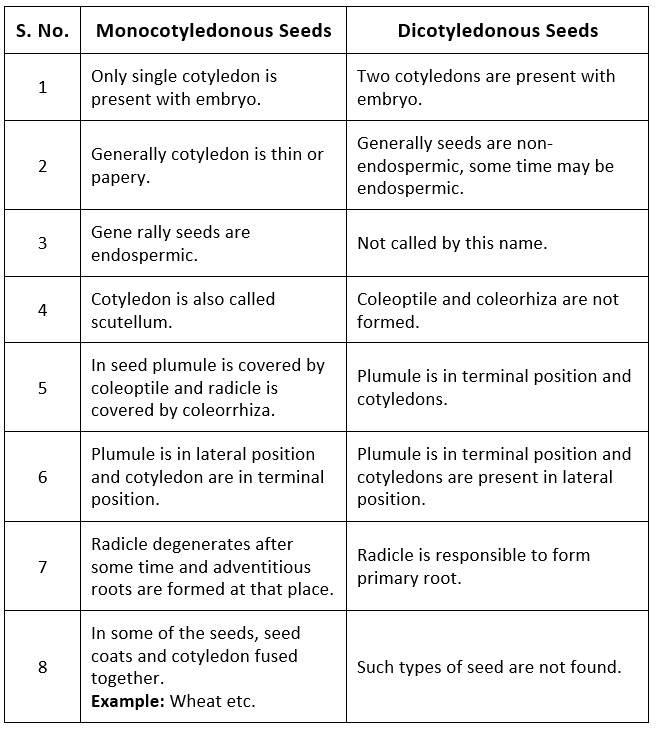
(i) Structure of Bean Seed (Dicotyledonous Seed)
- Bean seed is kidney-shaped having a concave side and a convex side.
 Structure of Bean Seed
Structure of Bean Seed - The concave side is slightly darker and posses a white elongated scar is called the hilum, which marks the point of attachment of the seed with the funiculus.
- A small pore lies adjacent to the hilum, called micropyle, which performs the function of absorbing water during germination.
- There is a short ridge on the other side of the hilum. It is called the raphe.
- The Bean seed has two seed coats. The outer seed coat is called testa. It is hard, thick, smooth and in various colours. It develops from the outer integument of the ovule.
- The inner coat is white, membranous and thin. It is called the tegmen. It is difficult to separate tegmen from testa. The seed coats can easily be removed if the seeds are soaked in water for a few hours. Each seed encloses an embryo which can be examined after removing the seed coats.
- The bulk of the embryo consists of two large, white and kidney-shaped cotyledons (or seed leaves). They store reserve food material in the form of carbohydrates and proteins to provide nourishment to the embryo at the time of seed germination and growth of the young seedling.
- The cotyledons are attached laterally to the curved embryonal axis at the cotyledonary node. The micropylar end of the embryonal axis is rod-shaped and slightly bulged. It is called radicle (or the embryonic root). The other side of the embryonal axis lies in between the two cotyledons. It is called plumule (or the shoot-tip).
- The shoot tip remains protected by two small, folded leaves. The portion of the embryo axis between the plumule and cotyledonary node is called epicotyl. The portion of the axis between the radicle and cotyledonary node is called the hypocotyl.
(ii) Structure of Maize Grain (Monocotyledonous Seed)
- A grain of maize (Zea mays) is in fact a dry one-seeded indehiscent fruit of caryopsis type in which pericarp (of fruit wall) is fused with the seed coat. The covering of grain encloses two major parts, an endosperm and an embryo. As seen in the longitudinal section, the major portion of grain is occupied by a large starchy endosperm.
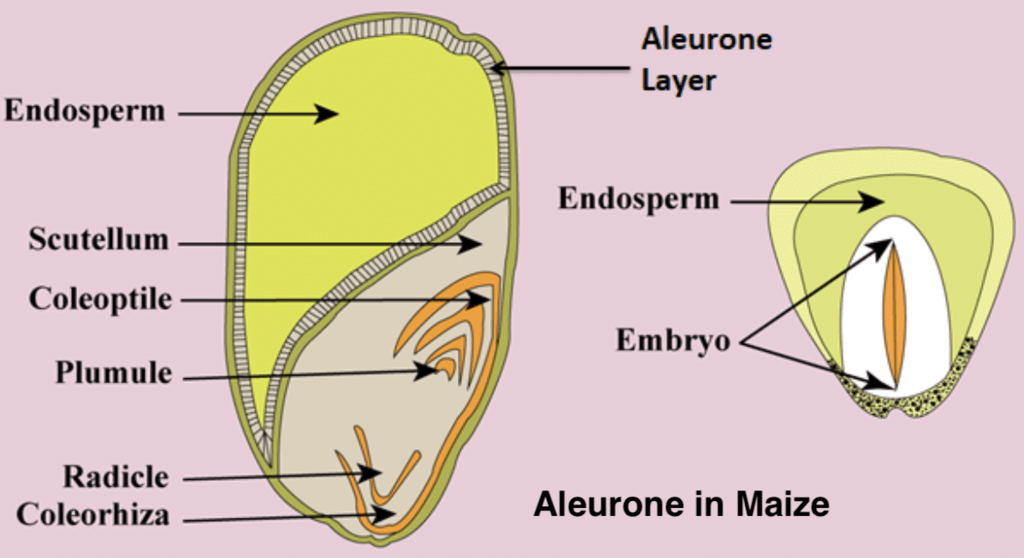
- It is surrounded by a special one-celled thick layer, called the aleurone layer. The cells of the aleurone layer are filled with proteinous grains which play an important role at the time of germination.
- The embryo consists of an upper shield-shaped scutellum which is actually a cotyledon. The scutellum is closely pressed against the endosperm and helps in the translocation of nutrients from endosperm to the growing embryo at the time of germination and seed growth.
- The epidermal tissue of the scutellum lying in direct contact with the endosperm is both secretory and absorptive in function. It secretes certain hormones into the endosperm which synthesize enzymes.
- These enzymes are responsible for the decomposition of stored nutrients and convert them into a soluble state. The soluble nutrients are then absorbed by the epithelial layer of scutellum and transferred to the growing embryo.
- The scutellum is attached laterally to the embryonal axis. One end of the embryonal axis points towards the pointed end of the grain. It is called the radicle. The radicle is covered by a protective sheath called coleorhiza.
- The other end of the embryonal axis, which faces towards the broader end of the grain, is called plumule. The plumule is surrounded by a conical protective sheath, called coleoptile. The coleoptile is capable of growth and covers the growing shoot tip till it passes through the soil during germination.
➢ Germination of Seed
- The process by which the dormant embryo wakes up (becomes active) and begins to grow is known as germination of seed.
- The embryo of the seed grows into a sporophyte plant. The radicle produces the primary root. The plumule develops short and later on cotyledons degenerates.
➢ Dormancy of Seed
- The presence of dormancy in a seed is the most important characteristic feature of plants. Because of this character, seeds remain viable for many years.
- The seeds are dispersed very far places through water, air or insects. Most of the seeds are unable to germinate just after dispersal. They germinate after some time.
- The time between the maturation and germination of the seed is known as the "Dormancy period". The state of inhibited germination as a result of internal causes is usually called 'dormancy'.
 Seed Dormancy
Seed Dormancy - This seed dormancy is of considerable advantage to the plant which helps to pass on adverse environmental conditions. The embryo remains inactive in this period and all the growth processes suspended temporarily.
Old NCERT Syllabus
➢ Different types of Seed Germination
Germination is basically of two types depending upon the behaviour of cotyledons but viviparous germination also found.
1. Epigeal Germination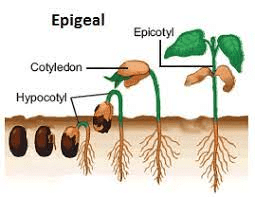 Epigeal Germination
Epigeal Germination
- Here due to hypocotyl growth or elongation, cotyledons are pushed out of the soil. This is called epigeal germination.
- This type of germination occurs in Cotton, Papaya, Castor, Onion, Cucurbits, Tamarind, French bean, mustard, etc.
- In some cases, these above ground cotyledons become green leaf-like (cotyledonary leaves) and perform photosynthetic function till the seedling assumes independency.
Example: Castor, cotton, onion, papaya, etc. - In other plants, cotyledons do not assume a leaf-like shape and fall off.
Example: French bean and Tamarind).
2. Hypogeal Germination
- Here due to growth in epicotyl plumule comes out of the ground and cotyledons remain underground. This is called hypogeal germination.
- This type of germination occurs in most of the monocotyledons and few dicotyledons.
Example: Maize, Rice, Wheat, Coconut, Gram, Pea, Peanut and Mango, etc. Hypogeal Germination
Hypogeal Germination
3. Vivipary
- It is a special type of seed germination that is characteristic of Mangrove vegetation, found in muddy, saline conditions.
Example: Rhizophora, Avicennia, Ceriops, Breguira, Sonneratia, etc. - Here there is no resting period of embryo and germination occurs inside the fruit, while it is attached to the parent plant, i.e., "in-situ germination".
- The seedling is separated in the mud with the help of lateral roots developing from the basal end of the radicle. This is called viviparous germination or vivipary.
Table: Differences between Epigeal and Hypogeal Germination

Factors Affecting Seed Germination
- The seed germination takes place in the presence of favourable condition such as temperature, moisture, and air.
- This is a very delicate stage in the life of the plant. Any minute change in the environment has a harmful effect on the growing embryo. So favourable environment should be essential for germination.
The following factors are essential for the germination of seed:
1. Moisture
- Moisture or water is the most important factor for the germination of seed. Generally, the cells of the embryo contain about 10-15% water in the dormancy period. The vital activities like growth and development are unable to continue in this less amount of water.
- For active life processes, water must be present at about 75-90%. The seed absorbs water and swells up to increase in size before germination. Water absorbs through seed coat and micropyle.
The following effects have been observed in seed due to absorption of water:
(i) The seed coat becomes soft and absorbed water reaches the cells of the embryo. When the ratio of water increases in the cells, the protoplasmic contents become more active.
(ii) The size of the embryo increased due to water absorption due to this, the seed coat breaks up and the radicle and plumule easily comes out. Seed coat absorbs water, it becomes soft and increases its permeability. Resulting in increasing the rate of exchange of oxygen and CO2. The rate of respiration increases inactive cells of the embryo. Thus it requires more oxygen.
(iii) The enzymes are present in the cells of endosperm or cotyledons which are active only in the presence of water. The stored food changed into dissolved form by the activity of enzymes and it reaches the active embryo.
2. Oxygen (O2)
- The process like cell division, cell elongation etc. of the embryo require energy. This energy is released by the oxidation of organic substances.
- Oxygen is essential for the oxidation process. The upper surface of soil contains a sufficient amount of O2.
- Healthy germination does not take place in the absence or scarcity of oxygen in deep soil so crop seed sown in the soil by the farmers up to 5-7 c.m. deep.
3. Temperature
- A suitable temperature is essential for the germination of seed.
- The protoplasm of the cell remains active at a certain range of temperature. Most seeds do not germinate in between the range of 0º C to 5º C and above 45º C.
- The favourable range of temperature is 20-25º C for germination of seed.
4. Food or Nutrition
- The growing embryo requires (needs) nutrition during germination. The embryo depends upon stored food materials in cotyledons or endosperm in the germination period up to the formation of the primary root from the radicle and the first leaf from the plumule.
5. Light
- Light produces a different effect in different variety of seeds. Most of the plants do not require light up to the formation of the first leaf.
- The rate of germination very fast in the absence of light. But for some plants light is very essential for germination. They will not germinate in the dark.
Example: seeds of Orchids, Tobacco, Mistletoe etc. - After the development of new leaves on the shoot, light becomes a very essential factor. The chlorophyll is not formed in the absence of light and this newly formed plant (juvenile) will die in the absence of photosynthesis and deficiency of food.
➢ Special Points
- The highest amount of fat is found in the endosperm of Coconut.
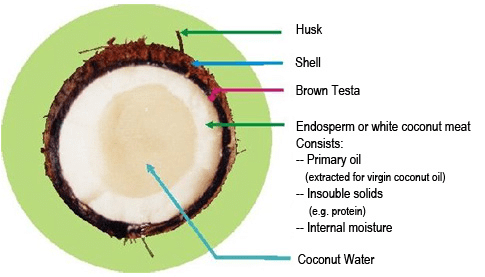 Coconut Structure
Coconut Structure
- The embryonic development of Capsella is endoscopic because it is developed towards the chalazal region of the zygote.
- Single-celled suspensor is found in Triticum (wheat) and Caryophyllum. Their seeds are caryopsis fruit.
- Suspensor is absent in Sunflower and Marigold.
- 125 meiotic divisions are essential for the development of 100 grains of Wheat.
- Two-generation and three genotypic cells are present in Angiospermic seed.
- The heaviest seed (6 k.g.) is found in Lodoshia. Its fruit is 1 meter in length and wt. of fruit is 18kg.
- The edible part of Betelnut is the endosperm.
- Abscisic acid is the natural germination inhibitor of seed.
- The anatomical transition from root to stem occurs in the hypocotyl region.
- Seed of the Ruella dispersed by jaculating or technique.
- Smallest or minute seeds are found in Orchids which are the lightest in plant kingdom and are called " Dust seeds " (weight 20.33 mg).
- Xenia (by Focke) - Effect of pollens inside Embryosac on Endosperm (except Embryo).
Example: Maize. - Metaxenia - Effect of pollen outside the Embryosac on seed coat or pericarp. In Datepalm, maturity time, as well as the size of fruits, can be changed by using different pollens.
- The pollen grains of insect-pollinated flower bears oily layer is called pollen-kitt. It is made up of lipid and carotenoids.
- The longest pollen tube is found in Maize.
- Seeds of a large number of species live for several years. Some seeds can remain alive for hundreds of years. There are several records of very old yet viable seeds. The oldest is that of a lupine, Lupinus arcticus excavated from Arctic Tundra. The seed germinated and flowered after an estimated record of 10,000 years of dormancy. A recent record of 2000 years old viable seed is of the date palm, Phoenix dactylifera discovered during the archaeological excavation at King Herod's palace near the Dead Sea.
- The endosperm is formed after the fertilization in Angiosperms. It is triploid while in Gymnosperm, the endosperm is formed before the fertilization and haploid in nature.
- Normally, Dicotyledon embryonic development is Crucifer-type which is also known as onagrad-type.
- The ovules of some parasitic plants do not have integument.
Example: Sandal (Santalum) and Viscum. Santalum (plant with no integument)
Santalum (plant with no integument) - The polysiphonous condition is found in families of Malvaceae and Cucurbitaceae.
- Those plants which live immortal through the seeds are known as therophytes.
- The synergids are absent in the embryo sac of Plumbago.
- The pollination takes place at the two-celled structure of pollen grains in most Angiosperms.
- Monosporic embryo sac extensively found in Angiosperm. It is discovered by Strasburger in Polygon undivarictum. It develops only from one functional megaspore.
- The seed of Cuscuta and Santalum lacks cotyledon.
- The middle layer is absent in Wolffia.
- Costum and Nicosia plants have multilayered tapetum.
- The dormancy is absent in the seed of most Crop plants and Mangroove plants like Rhizophora.
- The fruit formed from the ovary without fertilization is called "Parthenocarpic fruits".
- Lotus, Nymphaea and Alisma like aquatic plants are entomophilous.
- All the microspores of anther of Calotropis are joined together to form a special, structure called Pollinium. These staminal structures are called translate or apparatus.
- In some plants like Typha, Drosera, Cryptostegia all four microspores joined together and they are called Compound pollen.
- For the formation of the mature pollen grain, one meiotic and one mitotic division required. For the formation of mature male gametophyte, one meiotic and two mitotic divisions required.
- In Orchis maculata and Rumex, shaped tetrad of megaspore is formed (In most angiosperms generally linear tetrads are formed. Isobilateral, tetrahedral and decussate type tetrad of megaspores are absent).
- Balanophora and Oenothera plants one micropylar megaspore of tetrad becomes functional rest of three which are present towards the chalaza degenerate.
- When entry of male gametes into the embryo sac is not participating in fusion is called Semigamy.
- When two pollen tube enters into an ovule and releases their contents. It is possible that the one male gamete of one pollen tube fertilizes with the egg cell and one male gamete of another pollen tube participate in triple fusion (with a secondary nucleus). It is called hetero-fertilization. Because of this xenia effect found in Zea mays.
 Hetero Fertilization
Hetero Fertilization
- The white fluid is found in green coconut is nuclear endosperm which is known as "Cocos nucifera".
- In Cereals (Monocots) outer layer of endosperm is thick-walled with dense cytoplasm, which is mainly filled with aleurone grains (highly protein-rich) and hence called Aleurone Layer. This layer secretes some hydrolytic enzymes like proteases and amylases.
➢Reasons for Seed Dormancy
There are three main basic reasons for the dormancy of seed:
(i) Impermeability of Seed Coat
- The seed coats of many species of Leguminosae and Convolvulaceae families are completely impermeable to moisture (water) and oxygen at the time of their maturity. Seed coats, in these, are thick and hard.
- Their cell wall is covered by a layer of lignin which is a waterproof coating. Such seeds take more time for germination.
- Under natural conditions, seed dormancy is gradually overcome by the action of microbes (bacteria) in soil, in the alimentary canal of fruit eater birds and due to the presence of low or high temperature.
(ii) Dormant Embryo
- In many species, although, the embryo completely not matured when the seed is ripe, even then it fails to germinate whenever the environmental conditions are favourable or even the seed coat is removed. This is known as "Embryo dormancy".
- Normally embryo dormancy occurs in many fruits yielding plants of the forest. This condition is achieved due to the physiological action of the seed. Such type of seed must complete their enzymatic and chemical reaction before the germination of the seed.
- In the lack of these reactions, seeds are unable to germinate. such seed is kept in low temperature and in desirable moisture. Due to this seed dormancy can be broken. The low temperature is the main reason for the germination of seeds of Apple, Peaches, Pears, Mapple and Pine etc.
(iii) Germination Inhibitors
- Germination of some seeds is sometimes checked or prevented by the presence of some chemical compounds are called "Germination Inhibitors ".
Example: Ferulic acid present in Tomato juice, Coumarin, Abscisic Acid, Dormin and Para ascorbic acid etc. - This condition is generally found in xerophytic plants. These germination inhibitors washed away with water is known as "Leaching".
There are the following methods for the breaking of seed dormancy: Breaking of seed dormancy(i) Scarification: The hard seed coat is broken in this method so that water and oxygen enter into the seed coat.
Breaking of seed dormancy(i) Scarification: The hard seed coat is broken in this method so that water and oxygen enter into the seed coat.
The dormancy of seeds can be broken by different artificial methods:
- By making minute hole/pores with help of pointed sharp apparatus on the seed coat.
- The seeds are rubbed on a hard object so that the seed coat becomes thin.
- The partial degeneration of the seed coat is carried by the action of sulphuric acid.
(ii) Stratification: The seed kept at low temperature and in the presence of oxygen and water for some time, so that embryo can complete its maturation.
(iii) Light Requirement
- The seeds which are affected by the light are known as " Photoblastic seeds ".
- The seeds which germinate in the presence of light are called "positive photoblastic seeds".
Example: Lettuce, Capsella, Lepidium and Tobacco etc. - The seeds in which germination take place in the absence of light are called "negative photoblastic seeds".
Example: Nigella and Silene etc. - Some seeds that are not affected by light are called "non-photoblastic seeds".
- The dormancy of photoblastic seeds can be broken by the treatment of red light. The phytochrome red absorbs red light and converts into phytochrome far-red which increase the germination of seed.
Seed + R [red light] → Germination Seed + R + FR → No germination Seed + R + FR + R → Germination Seed + R + FR + R + FR → No germination
(iv) Alternative Temperature: Seeds are treated with high and low temperature alternatively at high pressure to increase the germination of seed.
Example: The seed of Malilotus (Sweet clover) and Alfa - alfa are treated at 2000 atmospheric pressure and 18º C temperature.
(v) Viability: This is called the existence of life in a seed. The viability of seed can be tested out by 2, 3, 5, triphenyl tetrazolium chloride. The embryonal axis of living seed becomes pink in colour in the solution of T.T.C.
(vi) Seed dormancy can also be broken by the treatment of G.A.
➢ Special Points
- The hard and impermeable seed coat is found in most of the legume plants which is the main reason for seed dormancy. A hard lignin water-resistant layer (seed coat) is present on the seed of some Leguminosae plants.
- Growth inhibitor is present in the endosperm of Iris, in the seed coat of Cucurbita and in the embryo of Xanthium.
- The seed dormancy in Eranthisheemalis and Ginkgo is present due to immature embryos.
- Some chemicals have been used successfully to interrupt seed dormancy caused by a resistant or hard impermeable seed coat.
Example: Potassium Nitrate, Ethylene, Chlorohydrine and Thiourea etc. - Atriplex seed contains a high concentration of salt at the time of dispersal, which does not allow germination.
➢ Bud Dormancy
 Bud Dormancy
Bud Dormancy Before showing their respective growth, the bud of many plants undergoes a dormant phase. This is known as bud dormancy. This period starts in late summer and terminate in the spring season.
(i) Causes of Bud Dormancy
- According to Hemberg in a woody plant, bud dormancy is caused by Abscisic acid. The level of endogenous ABA increases with the onset of the dormant period and decreases when it is broken.
- In a non-woody plant like Potato, the bud dormancy is again due to the presence of an inhibitor. Bannet Clark and Kefford (1953) identified this substance as Inhibitor-β. It present in the peel of dormant Potato tuber. The inhibitor-b is responsible for checking the sprouting of buds located in the 'eyes' of the Potato tuber.
- According to Wareing, bud dormancy, at least in a woody plant, is caused by short day length, while it is broken by a long day.
(ii) Breaking of Bud Dormancy
- Chilling: The bud dormancy of some plant can be broken if they are given cold temperature treatment for a specific duration.
- Alternating temperature treatment: The dormancy of buds of some plants can be broken, if they are subjected to low temperature (0°-10°C) for a brief duration and then given warm treatment.
- High-temperature treatment: If dry Potato tubers are stored at 35°C or moist at 20°C, the dormancy of the tubers buds is broken.
- Chemicals: Some chemicals like 2-chloro ethanol, Gibberellin and Thiourea are capable of breaking of dormancy of buds. Of these 2-chloro ethanol is very effective in breaking the dormancy of Potato tuber's buds. Endogenous Gibberellin plays a very significant role in controlling the dormancy of Potato tubers.
|
221 videos|172 docs|126 tests
|
FAQs on Post-Fertilisation: Development of Seed & Fruit - Biology for JAMB
| 1. What is the structure of a seed? |  |
| 2. What is the difference between monocotyledonous and dicotyledonous seeds? |  |
| 3. How does seed germination occur? |  |
| 4. What is seed dormancy? |  |
| 5. How does post-fertilization lead to the development of seeds and fruits? |  |





















